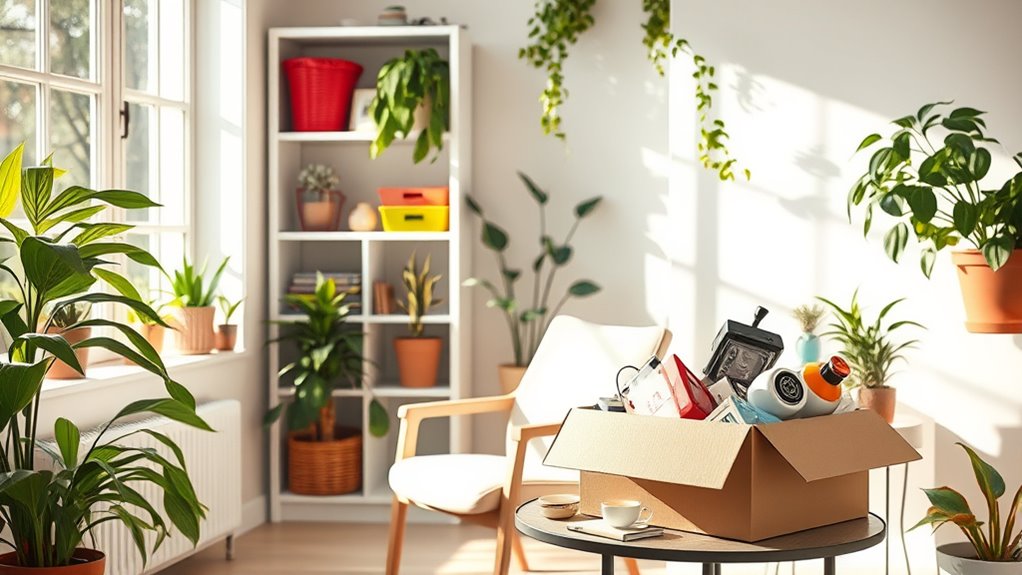The secret to decluttering when you hate it lies in understanding your resistance. Recognize what's holding you back, like sentimentality or fear of future needs. Set realistic goals and start small—focus on high-stress areas first. Gather supplies to help and break tasks into manageable steps. Acknowledge emotional attachments, but practice gratitude for items before parting with them. Celebrate small victories to keep your motivation up and discover effective strategies that fit your unique situation. More tips await to guide you through!
Key Takeaways
- Start small by decluttering one area or category at a time to avoid feeling overwhelmed.
- Set realistic, specific goals using the SMART framework to maintain focus and motivation.
- Acknowledge emotional attachments, but practice gratitude before letting go of items.
- Involve friends or family for support and accountability to stay motivated.
- Celebrate small victories to build momentum and reinforce positive decluttering habits.
Understanding Your Resistance to Decluttering

While you may feel motivated to declutter, various mental barriers can hold you back. Issues like depression and anxiety can sap your energy and focus, making it tough to start. Sentimentality also plays a big role; you might struggle to let go of gifts or heirlooms that hold emotional weight. The fear of needing items in the future can freeze you in place, while feelings of shame about your clutter can lead to avoidance. Overwhelm from the sheer volume of stuff can create paralysis, making it hard to move forward. Recognizing these barriers is the first step toward overcoming them and finding a path to a more organized space, especially because mental health issues can complicate your decluttering efforts. Understanding the importance of long-term financial planning can also alleviate some stress related to letting go of items you might feel obligated to keep.
Setting Realistic Goals for Your Decluttering Journey
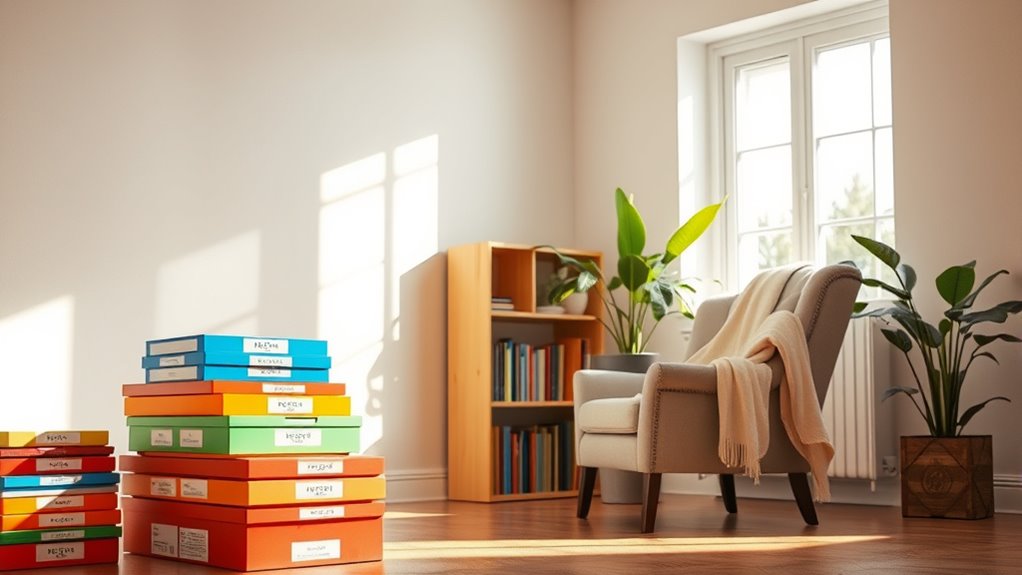
Understanding the mental barriers that hold you back from decluttering is vital, but it's equally important to set achievable goals for your journey. Start by defining your motivation—why do you want to declutter? Maybe it's to reduce stress or create a more organized space. Establish realistic timeframes for each task to avoid overwhelm, and prioritize areas that cause the most stress in your life. Break down larger tasks into smaller, manageable steps, and set SMART goals: Specific, Measurable, Achievable, Relevant, and Time-bound. Additionally, remember that setting clear goals can enhance motivation for decluttering. Implementing designated zones for specific activities can help streamline your efforts and make the process feel less daunting. Write your goals down and schedule decluttering sessions on a calendar, tracking your progress along the way. Regularly assess your goals and adjust them as needed to stay on track.
Choosing the Right Starting Point
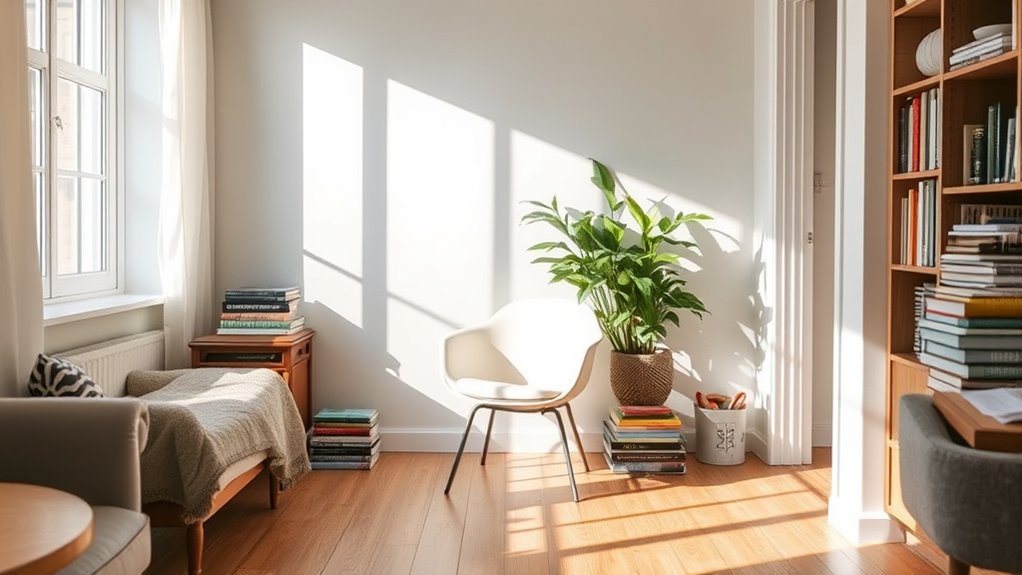
Where should you begin your decluttering journey? Start by identifying high-impact areas in your home, like the mudroom or laundry room, where clutter accumulates the most.
Focus on spaces that are frequently used or highly visible, as decluttering them will give you a significant boost. It's often best to tackle small, manageable spaces first to build momentum. Additionally, assess your personal energy levels; on low-energy days, opt for simpler tasks, while saving bigger projects for when you're feeling more energized. Remember that open communication about how a decluttering process makes you feel can enhance your motivation and help you stay committed.
Creating a checklist to track your progress is essential, as it helps you stay organized and focused on your goals, reinforcing the importance of decluttering and organizing. Remember that even small victories can motivate you to keep going.
Effective Strategies to Simplify the Process

To simplify your decluttering process, start by setting clear, achievable goals that break tasks into manageable segments. Use SMART goals—Specific, Measurable, Achievable, Relevant, and Time-bound—to keep track of your progress. A clean, simple home promotes peace and joy, making the decluttering journey more rewarding. Additionally, creating an environment that supports aging in place can motivate you to maintain a clutter-free space.
Prioritize areas needing the most attention, like high-traffic zones, and create a timeline to stay accountable. Gather essential supplies, such as trash bags and donation boxes, to facilitate your efforts.
Implement storage solutions like labeled bins for easy organization. Try short, 15-minute decluttering sessions, and tackle one room at a time for focus.
Celebrate small victories to stay motivated, and incorporate daily habits to prevent clutter buildup. Regular resets will help maintain your progress and keep your space organized.
Managing Emotional Attachments to Items
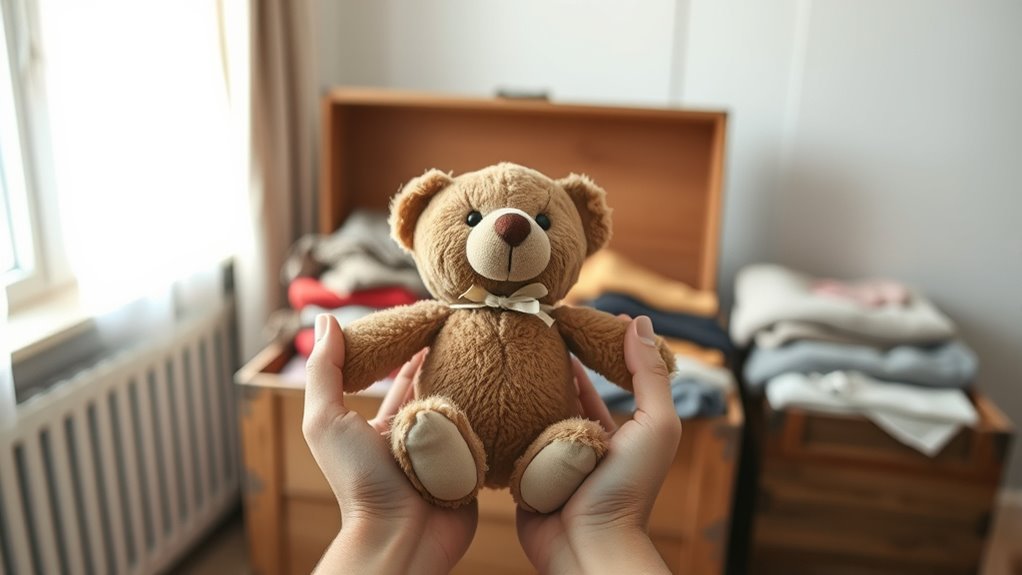
While decluttering can be a straightforward task, managing emotional attachments to items often complicates the process. You might find yourself holding onto belongings due to sentimental value or personal significance, especially after major life events like loss or trauma. These attachments can offer comfort but may also lead to clutter and stress. Recognizing when these attachments become problematic is crucial; if your space feels cluttered or your emotions are chaotic, it's time to reflect. Interpersonal trauma or loneliness can lead to forming bonds with objects instead of people, emphasizing the importance of understanding the roots of your attachment. Consider practicing gratitude for items before letting them go or repurposing them to maintain connections. Emotional healing is a gradual journey, and starting small—tackling items with less emotional weight first—can ease the process.
Creating a Sustainable Maintenance Plan
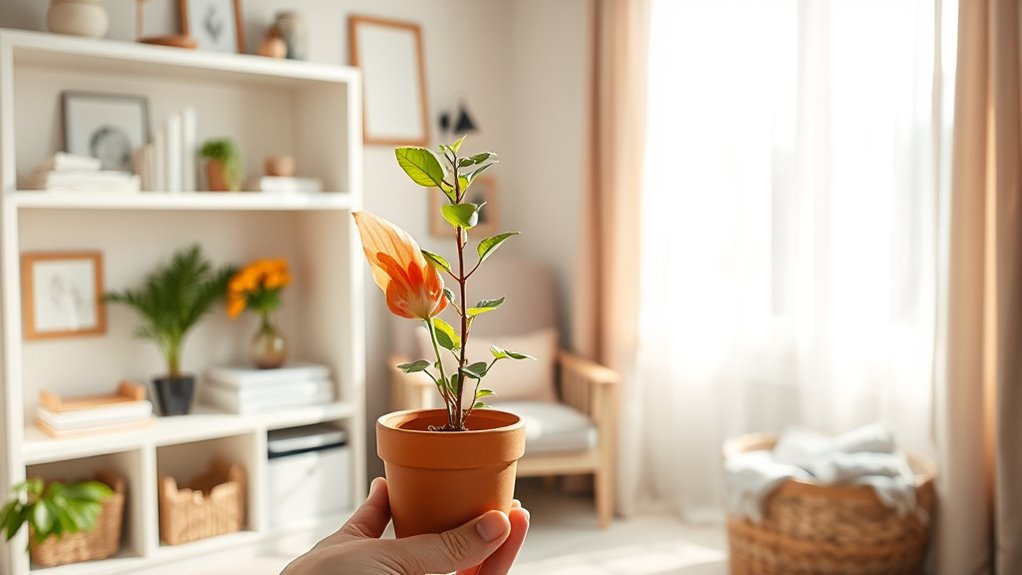
Creating a sustainable maintenance plan is essential for keeping your space clutter-free and organized over time. Start by defining specific, measurable goals for your decluttering journey. Focus on key areas, like your living room and kitchen, and create a realistic timeline for maintenance tasks.
Evaluate your current habits regarding consumption and disposal, aiming for a mindset shift towards minimalism and sustainability. Mindful decision-making can significantly enhance your ability to assess what you truly need and help you let go of unnecessary items.
Implement sustainable practices by repurposing old items, donating responsibly, and recycling correctly. Schedule regular purging sessions to prevent clutter buildup and adopt a one-in, one-out policy for new purchases.
Organize with purpose using eco-friendly storage solutions, and involve household members in these practices. By tracking your progress and adjusting your strategies, you'll maintain a clutter-free lifestyle effectively.
Celebrating Your Decluttering Achievements
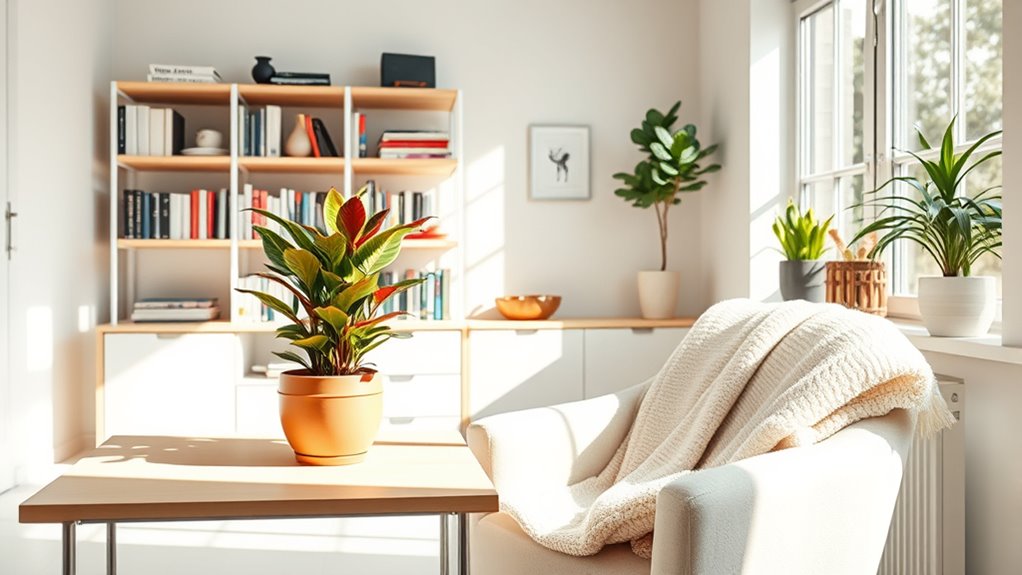
As you tackle your decluttering journey, celebrating your achievements along the way can significantly boost your motivation and reinforce positive habits.
Start by taking before and after photos to visually track your progress. Set milestones and reward yourself for completing tasks, whether it's treating yourself to a nice dinner or purchasing something you've wanted. Remember that regularly assessing your collection can help you maintain a clutter-free environment and ensure that items still hold value. Additionally, establishing consistent habits can make decluttering feel less overwhelming and more manageable over time.
Share your successes with friends or family for encouragement; their support can uplift you. Reflect on how decluttering has improved your life, helping you feel accomplished and reducing stress.
Frequently Asked Questions
How Do I Handle Clutter From Family Members?
To handle clutter from family members, start by assigning personal clutter bins for each person, encouraging them to empty their bins regularly.
Create a shared chore chart to distribute decluttering tasks fairly. Involve everyone in decision-making about what to keep or discard, and try making it a game to boost participation.
Establish clear expectations and routines to maintain a clutter-free environment, while also teaching organizational skills to help develop lifelong habits.
What Are the Best Donation Options for Unwanted Items?
When you're ready to donate unwanted items, consider these great options:
The Salvation Army accepts furniture and clothing.
Goodwill supports job training while taking electronics and housewares.
Habitat for Humanity focuses on furniture and building materials.
You can also use DonationTown to find local charities that offer free pickup.
How Can I Stay Motivated During Long Decluttering Sessions?
To stay motivated during long decluttering sessions, set small goals and take regular breaks.
Use timers to create focused intervals, making the task feel manageable.
Visualize your clutter-free space and remind yourself of the benefits, like reduced stress and increased efficiency.
Make it enjoyable by listening to music or podcasts.
Celebrate your progress, no matter how small, to reinforce your motivation and keep you moving forward in the decluttering process.
Should I Keep Items for Future Kids or Relatives?
Keeping items for future kids or relatives can feel like holding onto a treasure chest of memories, but it's essential to weigh their significance.
Ask yourself if these items truly align with your values and if they'll bring joy to future generations. Communicate with your family about what they might want.
If an item doesn't spark joy or serve a purpose, it might be time to let it go and lighten your load.
What Are the Consequences of Keeping Too Much Clutter?
Keeping too much clutter can seriously impact your mental and physical health.
You might feel more stressed, anxious, or even depressed, as clutter overwhelms your space and mind. It can lead to accidents, like slips and falls, and increase allergens in your environment.
Moreover, clutter can strain relationships due to frustration and social withdrawal. Ultimately, it reduces your focus and productivity, making it tough to enjoy a clear, organized life.
Conclusion
Decluttering might feel like climbing a mountain, but with the right approach, you can reach the summit. Remember, it's okay to take small steps and tackle one area at a time. Embrace your progress, no matter how minor it seems, and keep your emotional attachments in check. By creating a sustainable plan, you'll not only enjoy a tidier space but also a clearer mind. So grab your gear and start your journey—your serene sanctuary awaits!
